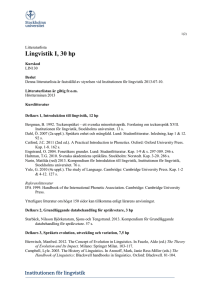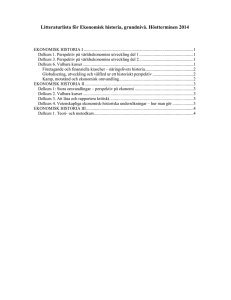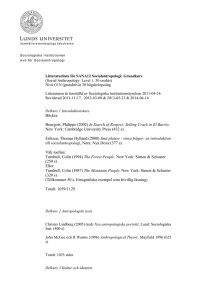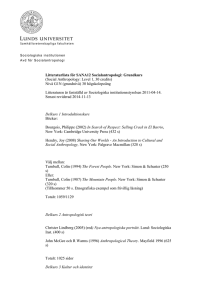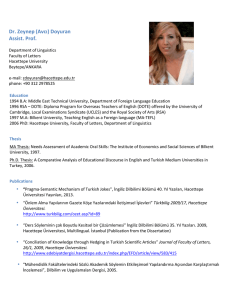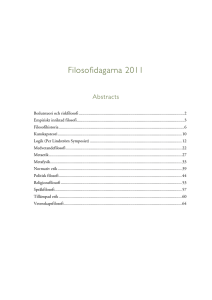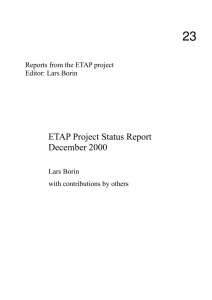LIN130 Litteraturlista VT15 - Institutionen för lingvistik
advertisement
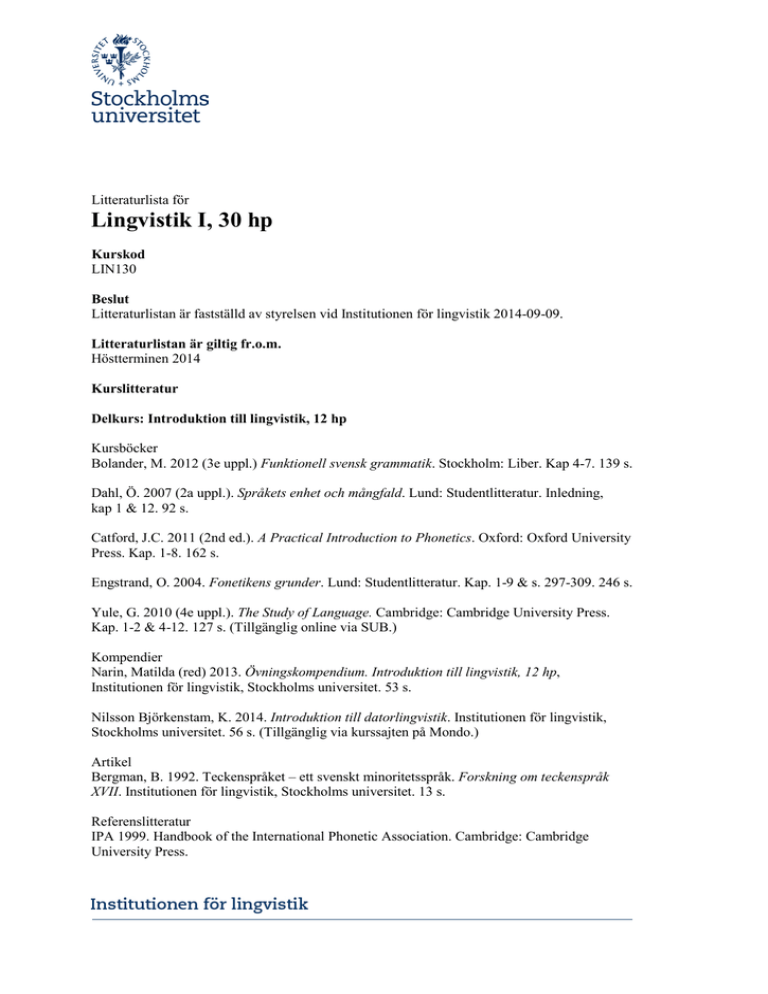
Litteraturlista för Lingvistik I, 30 hp Kurskod LIN130 Beslut Litteraturlistan är fastställd av styrelsen vid Institutionen för lingvistik 2014-09-09. Litteraturlistan är giltig fr.o.m. Höstterminen 2014 Kurslitteratur Delkurs: Introduktion till lingvistik, 12 hp Kursböcker Bolander, M. 2012 (3e uppl.) Funktionell svensk grammatik. Stockholm: Liber. Kap 4-7. 139 s. Dahl, Ö. 2007 (2a uppl.). Språkets enhet och mångfald. Lund: Studentlitteratur. Inledning, kap 1 & 12. 92 s. Catford, J.C. 2011 (2nd ed.). A Practical Introduction to Phonetics. Oxford: Oxford University Press. Kap. 1-8. 162 s. Engstrand, O. 2004. Fonetikens grunder. Lund: Studentlitteratur. Kap. 1-9 & s. 297-309. 246 s. Yule, G. 2010 (4e uppl.). The Study of Language. Cambridge: Cambridge University Press. Kap. 1-2 & 4-12. 127 s. (Tillgänglig online via SUB.) Kompendier Narin, Matilda (red) 2013. Övningskompendium. Introduktion till lingvistik, 12 hp, Institutionen för lingvistik, Stockholms universitet. 53 s. Nilsson Björkenstam, K. 2014. Introduktion till datorlingvistik. Institutionen för lingvistik, Stockholms universitet. 56 s. (Tillgänglig via kurssajten på Mondo.) Artikel Bergman, B. 1992. Teckenspråket – ett svenskt minoritetsspråk. Forskning om teckenspråk XVII. Institutionen för lingvistik, Stockholms universitet. 13 s. Referenslitteratur IPA 1999. Handbook of the International Phonetic Association. Cambridge: Cambridge University Press. 2 (3) Ytterligare litteratur om högst 150 sidor kan tillkomma enligt lärarens anvisningar. Delkurs: Grundläggande databehandling för språkvetare, 3 hp Starbäck, Nilsson Björkenstam, Sjons och Tengstrand. 2014. Kompendium för Grundläggande databehandling för språkvetare. Kompendiet finns tillgängligt via kurssajten på Mondo vid kursstart. Delkurs: Språkets evolution, utveckling och variation, 7,5 hp Kursböcker Dahl, Östen. Språkets enhet och mångfald. Lund: Studentlitteratur. Distin, Kate. 2010. Cultural Evolution. Cambridge University Press Online. (Tillgänglig online) Evans, Nicholas. 2010. Dying Words: Endangered Languages and What They Have To Tell Us. Oxford: Wiley-Blackwell. (Tillgänglig online) Tomasello, Michael. 2008. Origins of Human Communication. Cambridge, MA: MIT Press. (Tillgänglig online) Kapitel i böcker Bierwisch, Manfred. 2012. The Concept of Evolution in Linguistics. In Fasolo, Aldo (ed.) The Theory of Evolution and Its Impact. Milano: Springer Milan. 103-117. Campbell, Lyle. 2003. The History of Linguistics. I Aronoff, Mark, Janie Ress-Miller (eds.) The Handbook of Linguistics: Blackwell handbooks in linguistics. Oxford: Blackwell. 81-104. Carstairs-McCarthy, Andrew. 2003. Origins of Language. In Aronoff, Mark, Janie Ress-Miller (eds.) The Handbook of Linguistics: Blackwell handbooks in linguistics. Oxford: Blackwell. 1-18. Cotterill, Janet. 2012. Corpus Analysis in Forensic Linguistics. The Encyclopedia of Applied Linguistic. Oxford: Blackwell. 1-8 Eriksson, Anders. 2005. Tutorial on forensic speech science. Part 1. Forensic phonetics. In Interspeech 2005 Eurospeech. Proceedings of the 9th European Conference on Speech Communication and Technology, Lisbon, Portugal 2005. Kurzweil, Ray. 1998. When will HAL understand what we are saying? Computer speech recognition and understanding. I Stork, David G. HAL's Legacy: 2001's Computer As Dream and Reality. Cambridge, MA: MIT Press. Tillgänglig online på http://www.kurzweilai.net/when-will-halunderstand-what-we-are-saying-computer-speech-recognition-and-understanding Artiklar i tidskrifter Fitch, Tecumseh W. 2000. The evolution of speech: a comparative review. Trends in Cognitive Sciences, Vol. 4:7, 258-267. Fitch, Tecumseh, W. 2010. The evolution of language. New Scientist: The instant expert 6. Issue 2789, 7 pp. Hauser, Marc D., Noam Chomsky and W. Tecumseh W. Fitch. 2002. The Faculty of Language: What Is It, Who Has It, and How Did It Evolve? Science 22: 298 (5598), 1569-1579. 3 (3) Hockett, Charles F. 1960. The origin of speech. Scientific American 203:3, 88-96. Kuhl, Patricia K. 2004. Early language acquisition: Cracking the speech code. Nature Reviews: Neuroscience 5:11, 831-843. Robson, David. 2012. When did our language ability evolve? New Scientist, Issue 2857: 38. Delkurs: Att studera kommunikation, 7,5 hp Allwood, J. 2007. Multimodal Corpora. I Lüdeling, A. & Kytö, M. (red.). Corpus Linguistics: An International Handbook. Berlin: Mouton de Gruyter. 207-225. 19 s. Nilsson Björkenstam, Kristina, Elisabet Eir Cortes, Tove Gerholm, Mattias Heldner, Johan Sjons, Lisa Tengstrand. 2013 Att studera kommunikation (kompendium). Institutionen för lingvistik, Stockholms universitet. Bruce, G. 2012. Prosodisk transkription. I Allmän och svensk prosodi. Lund: Studentlitteratur. 167189. 23 s. Couper-Kuhlen, E., & Selting, M. 2001. Introducing interactional linguistics. I M. Selting, M. & Couper-Kuhlen, E. (red.). Studies in Interactional Linguistics Philadelphia, PA, USA: John Benjamins Publishing Company. 1-22. 22 s. ELAN How-to Guide. 2011. http://tla.mpi.nl/wp-content/uploads/2011/12/How-to-pages_5.pdf. Kendon, A. 1967. Some functions of gaze-direction in social interaction. Acta Psychologica, 26(C), 22-63. 42 s. http://dx.doi.org/10.1016/0001-6918(67)90005-4 Lindblad, P. 2005. Taltranskription (kompendium). Lund: Lingvistik, Lunds universitet. Ytterligare litteratur om högst 150 sid kan tillkomma enligt lärarens anvisningar. Referenslitteratur IPA. 1999. Handbook of the International Phonetic Association (A guide to the use of International Phonetic Alphabet). Cambridge: Cambridge University Press.
